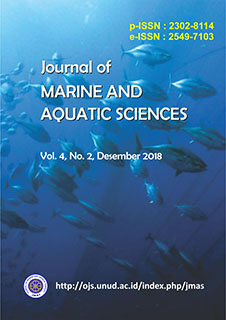Pendugaan Kejadian Pemutihan Karang Berdasarkan Analisis Suhu Permukaan Laut (SPL) Tahun 2015-2016 di Perairan Bali
Abstract
National Ocean Atmospheric Administrations (NOAA) by the program coral reef Watch (CRW) has developed a method to estimate the potential of coral bleaching using Sea Surface Temperature (SST). The products are hot spot (HS) and degree heating week (DHW). HS is the SST 1°C (SSTL?1) above normal and DHW is the length of HS inhabits a place. The CRW product do not provided detail informations because it has a lower resolution. It is need a satellite image with a higher resolution to provide better informations. One of the satellite images that can be used is Moderate Resolution Imaging Spectroradiometer (MODIS) with a spatial resolution of 1 km. The purpose of this study was to know HS and DHW distribution patterns and status of coral bleaching in Bali waters seen from the analysis of HS and DHW. MODIS data is used daily, then do mosaicing process to get a weekly SPL (8 daily) and the monthly SST. Monthly SPL normally used to get maximum montly mean (MMM). HS obtained from the difference between 8 daily weekly SST and SST normal (MMM).).Location bleaching based on data Coral Triangle Center (CTC) and coralwatch.org. SST results revealed difference of SPL in 2015 and 2016 amounted to 1.48°C. Highest DHW in Bali Hai, Nusa Penida is 10 465° C-weeks in April 2016. Based on the value HS and DHW coral reefs in Bali waters threatened bleaching level Alert 1 and Alert level 2.
Downloads

This work is licensed under a Creative Commons Attribution 3.0 International License.
Copyright 2012 - 2023 Journal of Marine and Aquatic Sciences (JMAS)
Published by Fakultas Kelautan dan Perikanan Universitas Udayana, Denpasar, Bali, Indonesia
JMAS (p-ISSN 2302-8114; e-ISSN 2549-7103)


